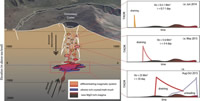Shallow system rejuvenation and magma discharge trends at Piton de la Fournaise volcano (La Réunion Island)
Coppola D., A. Di Muro, A. Peltier, N. Villeneuve, V. Ferrazzini, M. Favalli, P. Bachèlery, L. Gurioli, A.J.L. Harris, S. Moune, I. Vlastélic, B. Galle, S. Arellano, A. Aiuppa (2017).
Earth and Planetary Science Letters, 463, 13-24, http://dx.doi.org/10.1016/j.epsl.2017.01.024.
Abstract
Basaltic magma chambers are often characterized by emptying and refilling cycles that influence their evolution in space and time, and the associated eruptive activity. During April 2007, the largest historical eruption of Piton de la Fournaise (Île de La Réunion, France) drained the shallow plumbing system (>240×106 m3>240×106 m3) and resulted in collapse of the 1-km-wide summit crater. Following these major events, Piton de la Fournaise entered a seven-year long period of near-continuous deflation interrupted, in June 2014, by a new phase of significant inflation. By integrating multiple datasets (lava discharge rates, deformation, seismicity, gas flux, gas composition, and lava chemistry), we here show that the progressive migration of magma from a deeper (below sea level) storage zone gradually rejuvenated and pressurized the above-sea-level portion of the magmatic system consisting of a vertically-zoned network of relatively small-volume magma pockets. Continuous inflation provoked four small (<5×106 m3<5×106 m3) eruptions from vents located close to the summit cone and culminated, during August–October 2015, with a chemically zoned eruption that erupted 45±15×106 m345±15×106 m3 of lava. This two-month-long eruption evolved through (i) an initial phase of waning discharge, associated to the withdrawal of differentiated magma from the shallow system, into (ii) a month-long phase of increasing lava and SO2 fluxes at the effusive vent, coupled with CO2 enrichment of summit fumaroles, and involving emission of less differentiated lavas, to end with, (iii) three short-lived (∼2 day-long) pulses in lava and gas flux, coupled with arrival of cumulative olivine at the surface and deflation.
The activity observed at Piton de la Fournaise in 2014 and 2015 points to a new model of shallow system rejuvenation and discharge, whereby continuous magma supply causes eruptions from increasingly deeper and larger magma storage zones. Downward depressurization continues until unloading of the deepest, least differentiated magma triggers pulses in lava and gas flux, accompanied by rapid contraction of the volcano edifice, that empties the main shallow reservoir and terminates the cycle. Such an unloading process may characterize the evolution of shallow magmatic systems at other persistently active effusive centers.
http://www.sciencedirect.com/science/article/pii/S0012821X17300365


